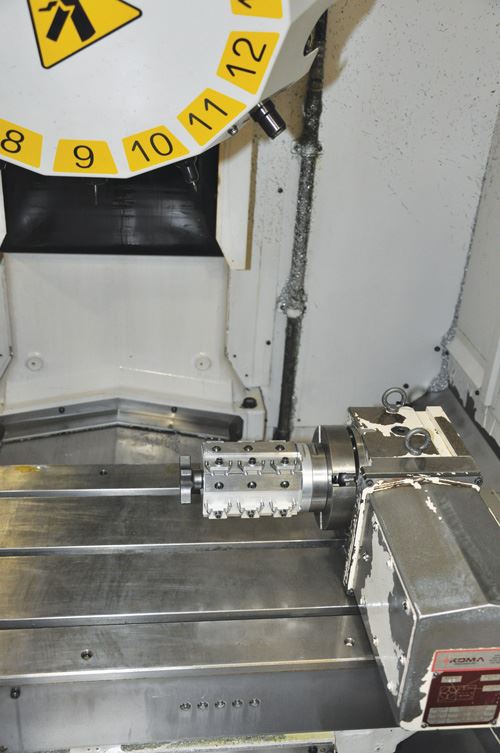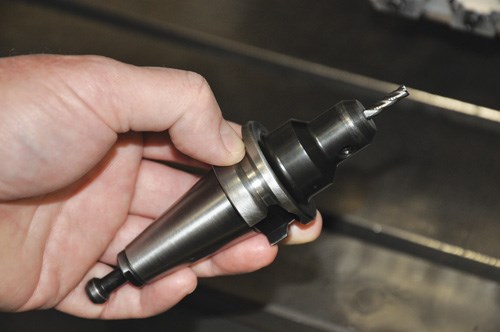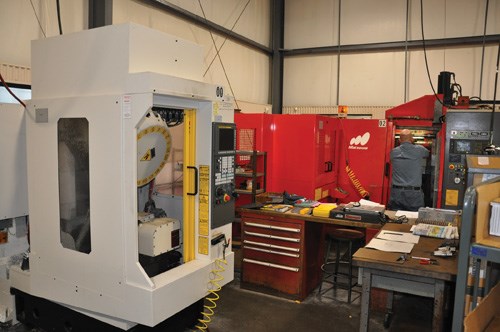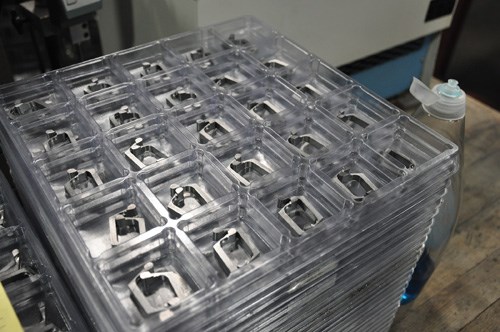Looking At 30-Tapers In A New Light
The six 30-taper machine tools in one Northeastern shop are used for more than just drilling holes and performing secondary operations. The small-footprint equipment is also used to machine parts complete from titanium and other challenging materials.
Share





I enjoy visiting shops that use equipment in ways you wouldn’t expect. Fairview Machine (www.fairviewmachine.us) is one of those shops.
The Topsfield, Massachusetts shop has a number of beefy three-, four- and five-axis Matsuura machining centers. It’s not surprising to see that equipment aggressively milling titanium, stainless steel and other such pain-in-the-butt materials. Sprinkled throughout the shop, however, are six, smallish Fanuc RoboDrills that are completely machining select workpieces from some of those same alloys.
Of course, these 30-taper machines aren’t taking heavy cuts in those materials like the Matsuuras. David Snow points out, though, that given the right application, the small-footprint machines—used by many shops only for drilling, tapping or secondary operations—are perfectly capable of completely machining challenging workpiece materials.
Mr. Snow, the shop’s vice president and general manager, remains tight-lipped about some of the proprietary techniques the shop applies when milling difficult materials on its RoboDrills. During a recent visit, however, he described how the shop’s use of its 30-taper machines has evolved over the years and highlighted the ways it effectively produces select high-margin parts on its compact machine tools.
Applying 30-Tapers
Fairview Machine was established in 1962 to provide precision contract manufacturing services to the government and to various industrial customers. Nowadays, business is essentially a 60/40 split between defense and medical work. Mr. Snow says titanium and aluminum alloys represent 90 percent of the materials that flow through the shop. The rest is chiefly plastics and stainless steels. Although the 56-employee company primarily performs milling work, it also has seven Nakamura-Tome CNC lathes and a couple of Fanuc wire EDM units, in addition to various other supplemental machining equipment, to round out its manufacturing capabilities.
The shop’s first RoboDrill was a five-axis model purchased in 2001 through Methods Machine Tools Inc. (Sudbury, Massachusetts), which is its primary machine-tool supplier. The RoboDrill was brought in to provide secondary engraving and tapping operations for a specific medical job the shop had won. At that time, the shop didn’t have a small CNC machine to serve that type of supporting role for its large equipment. Soon after, Fairview found additional secondary work for the 30-taper machine, exemplified by relatively small castings that were being machined on one of the shop’s larger five-axis machines. Each casting, which required some drilling and light milling operations, took 14 minutes to complete on the big machine, Mr. Snow says. The RoboDrill could complete each part in 6 minutes, largely due to its smaller work envelope as well as faster rapid traverse rates and tool-change time. That freed the larger machine to run jobs that were better suited for its capabilities and capacity.
The shop now has six RoboDrills, including four-axis, five-axis and pallet-changing versions. These days, however, those machines are used for more than just secondary operations.
Machining Complete
Manufacturers of 30-taper machine tools have increased the rigidity of their designs over the years to allow that equipment to perform more than just drilling and tapping operations. Mr. Snow says the RoboDrill platform offers sufficient stiffness to machine even some titanium and stainless steel alloys when using rigid tooling and fixturing and taking light cutting passes. In a sense, the shop applies high speed machining principles commonly used by aerospace shops when they mill large aluminum components. Stubby, ball end mills are typically used to take light cuts at fast feed rates in titanium and stainless parts. Minimizing tool gage length helps maximize stiffness. According to Mr. Snow, light cuts are also less likely to introduce stress into the material, so parts with thin walls won’t “pop” out of shape after machining. He says the shop can routinely hold tolerances of 0.0005 inch with RoboDrills.
Mr. Snow caps spindle speed for all machines at 12,000 rpm, even though some of the RoboDrills offer 15,000 rpm. He does this for two reasons. First, he doesn’t want to risk wearing spindles prematurely. Second, limiting spindle speed to 12,000 rpm makes it unnecessary to used balanced toolholders.
Fixturing is the third key element to overall system rigidity, in addition to machine design and tooling. The shop creates most of the fixturing devices used on all of its machines. Mr. Snow says it’s vital that all part seating surfaces are perfectly flat so that parts are drawn completely flush with the fixture, giving them no chance to twist or move during machining.
The fixture shown to the right is a good example of one of the shop’s designs for a typical titanium job carried out on a RoboDrill. That fixture secures 12 small rifle scope components—three per fixture face—to allow a long stretch of unattended machining. Five-axis positioning also allows the machine to mill more features per set up. Tighter tolerances are possible when setups and part handling are minimized, Mr. Snow notes.
Added Opportunities
Shops benefit from 30-taper machines in a variety of ways. These machines tend to be more energy efficient, less costly to tool and easier to maintain than larger models. Overall compactness is another aspect of these machines that Fairview, in particular, appreciates because the shop has limited potential to expand its facility. Many of the parts the shop machines are smaller than a breadbox anyway, so there is no sense wasting floor space for such applications when a small machine has the accuracy to produce them. The low-cost machines have also allowed Fairview to more aggressively pursue prototype work because it’s no longer necessary to tie up a big machine with a one-off project.
Mr. Snow suggests that shops look at some of the smaller jobs they currently run on large equipment and consider whether a low-cost, 30-taper machine might be more effective. This strategy can not only offer a means to boost shop profits, but also free a bigger machine to perform the type of work it was designed to do.
Related Content
The Future of High Feed Milling in Modern Manufacturing
Achieve higher metal removal rates and enhanced predictability with ISCAR’s advanced high-feed milling tools — optimized for today’s competitive global market.
Read More5 Tips for Running a Profitable Aerospace Shop
Aerospace machining is a demanding and competitive sector of manufacturing, but this shop demonstrates five ways to find aerospace success.
Read MoreLean Approach to Automated Machine Tending Delivers Quicker Paths to Success
Almost any shop can automate at least some of its production, even in low-volume, high-mix applications. The key to getting started is finding the simplest solutions that fit your requirements. It helps to work with an automation partner that understands your needs.
Read MoreInside the Premium Machine Shop Making Fasteners
AMPG can’t help but take risks — its management doesn’t know how to run machines. But these risks have enabled it to become a runaway success in its market.
Read MoreRead Next
Setting Up the Building Blocks for a Digital Factory
Woodward Inc. spent over a year developing an API to connect machines to its digital factory. Caron Engineering’s MiConnect has cut most of this process while also granting the shop greater access to machine information.
Read MoreBuilding Out a Foundation for Student Machinists
Autodesk and Haas have teamed up to produce an introductory course for students that covers the basics of CAD, CAM and CNC while providing them with a portfolio part.
Read MoreRegistration Now Open for the Precision Machining Technology Show (PMTS) 2025
The precision machining industry’s premier event returns to Cleveland, OH, April 1-3.
Read More


































